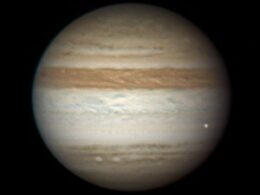Posted on September 30th, 2010
NASA astronomers have discovered the first Earth-like planet around another star that could be home to life as we know it. In an exciting development, they identified the remote world as being in an orbit where liquid water can exist on its surface.

The planet, labelled Gliese 581g, lies just 20 light-years away from our own solar system in the constellation of Libra.
After 11 years of study, scientists are confident that the planet lies bang in the middle of the so-called Goldilocks zone around its home star.
That is the habitable region which is not too hot and not too cold for Earth-like life to exist, providing there is water and a breathable atmosphere
The planet, which is too remote to be seen, was detected from the W M Keck Observatory on Hawaii by using a spectrometer to measure the wobble in its home star’s position during every orbit.
Astronomers discovered that Gliese 581g is only three or four times as massive as the Earth and 1.2 to 1.4 times its diameter – which is small compared to the giant gas balls that most new planets have been found to be.
It has a roughly circular orbit, like most of the Sun’s planets, and has a year just 37 days long – the time it take to make one circuit of its own star.
The planet is said to be “tidally-locked” which means it keeps the same side facing the star all the time, just as the Moon always keeps the same face towards the Earth. That means that its dark side is likely to be exceptionally cold and the lit side extremely hot. The most favourable area for life could therefore be along the edge where daylight meets night, called the terminator.
Gliese 581g is one of two new planets discovered orbiting the star, bringing its number of worlds to six. It had been suggested in 2007 that another planet in the system, Gliese 581c, might also have favourable conditions but it seems far less suitable than the new world.
Last month another star, in the constellation of Hydra, was reported to have seven planets.
Our own solar system has eight planets plus Pluto which was relegated to the second division in 2006.
Professor Steven Vogt, of the University of California, Santa Cruz, who co-led the study, said: “Our findings offer a very compelling case for a potentially habitable planet. The fact that we were able to detect this planet so quickly and so nearby tells us that planets like this must be really common.”
In March, a planet orbiting a star in Serpens Cauda was said to be cool enough to contain liquid water but that world is thought to be made mainly of gas and so quite unlike the Earth. Astronomers expect to discover more rocky planets using NASA’s Kepler space telescope and Europe’s Corot probe.
• Discover space for yourself and do fun science with a telescope. Here is Skymania’s advice on how to choose a telescope. We also have a guide to the different types of telescope available. Check out our monthly sky guide too!




